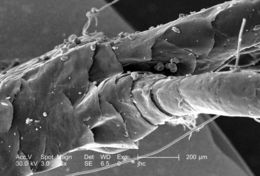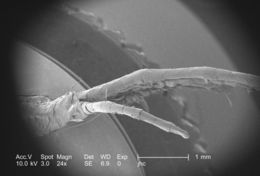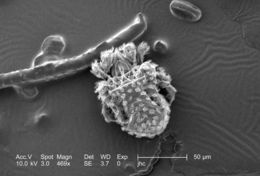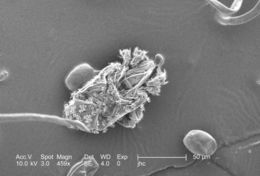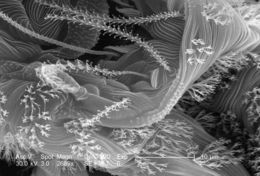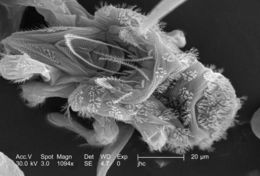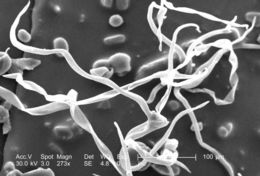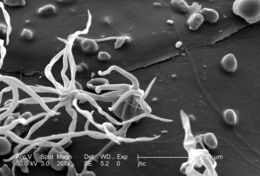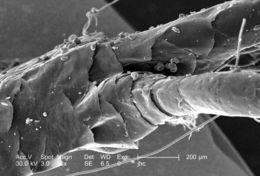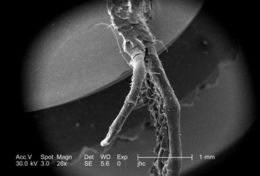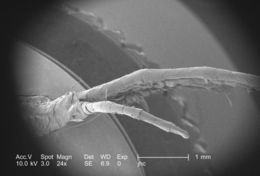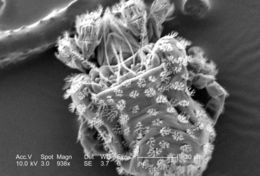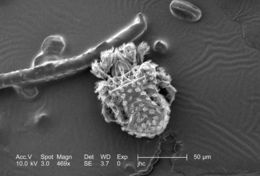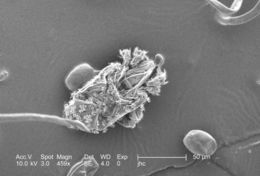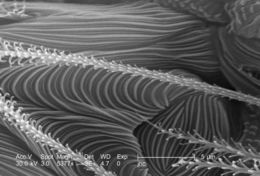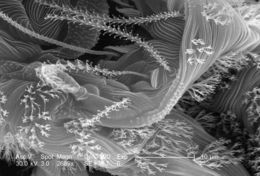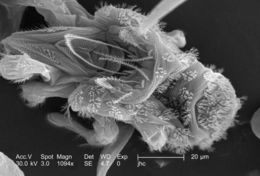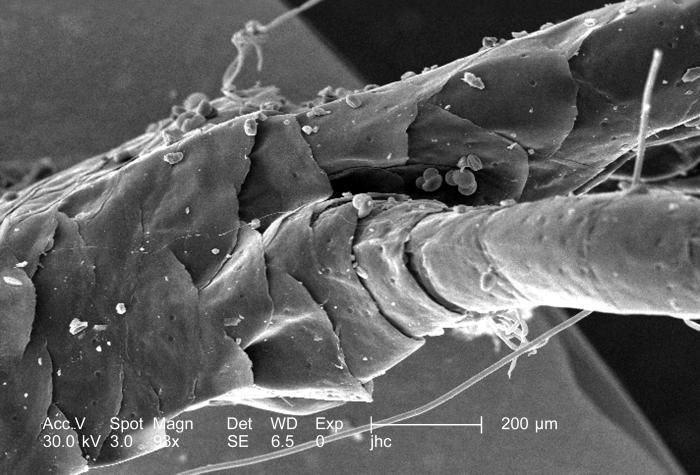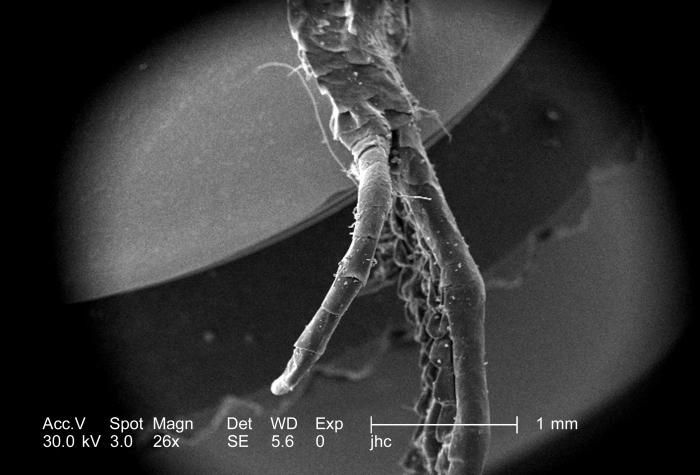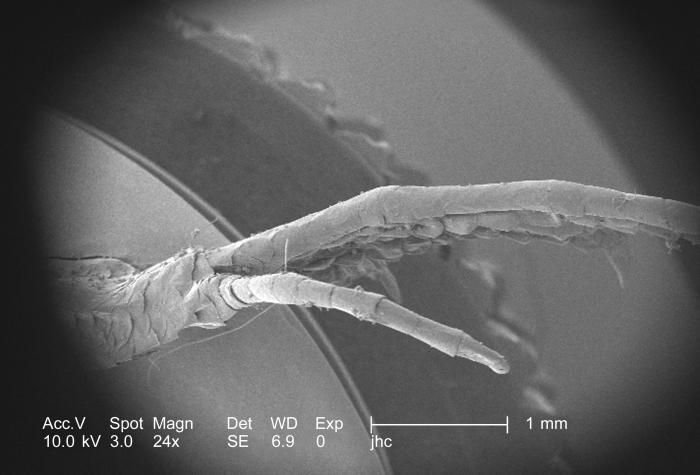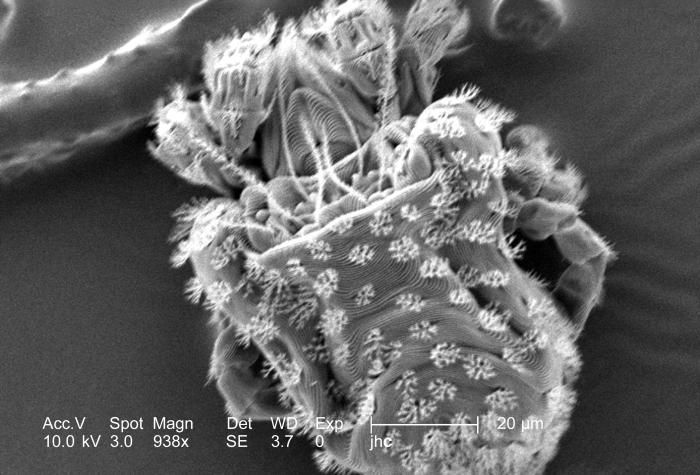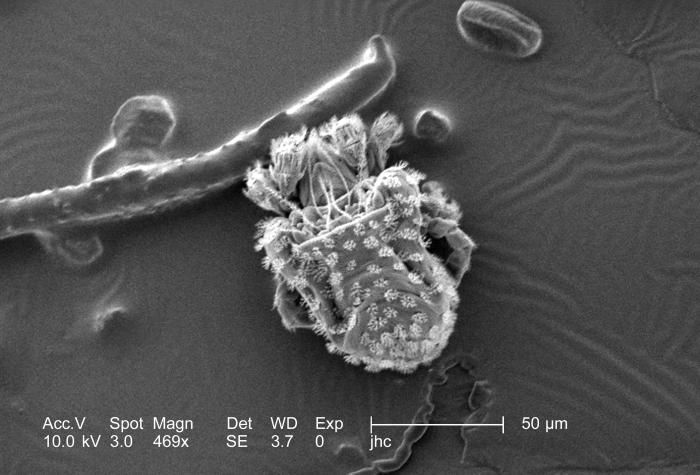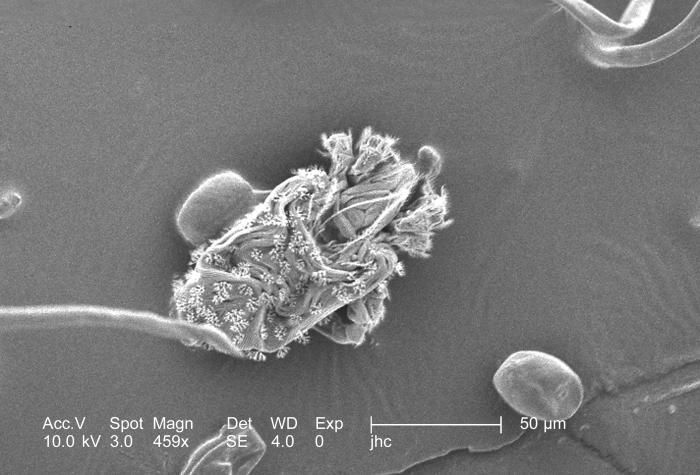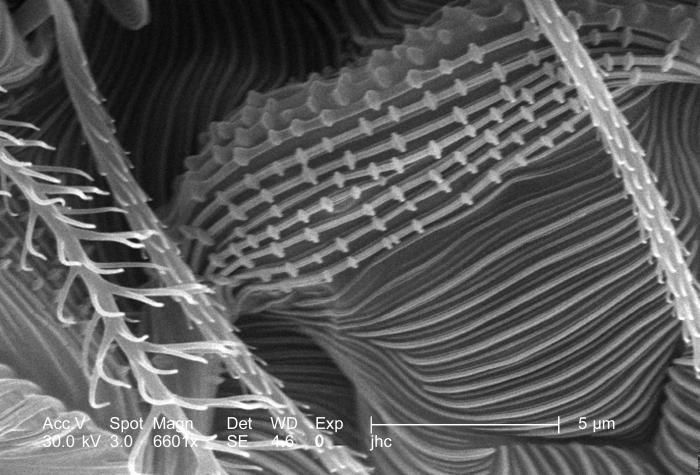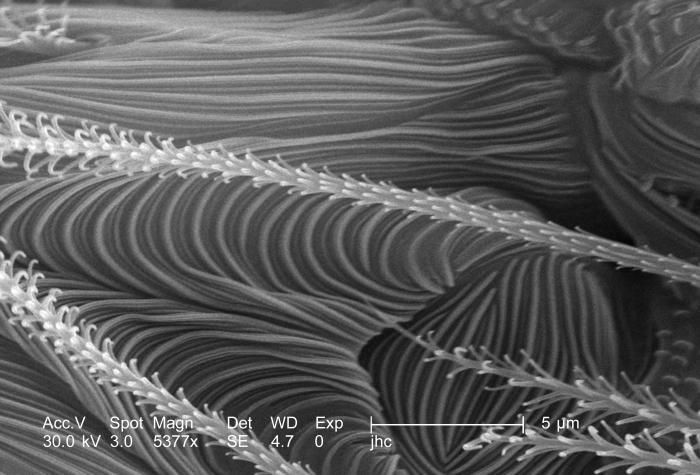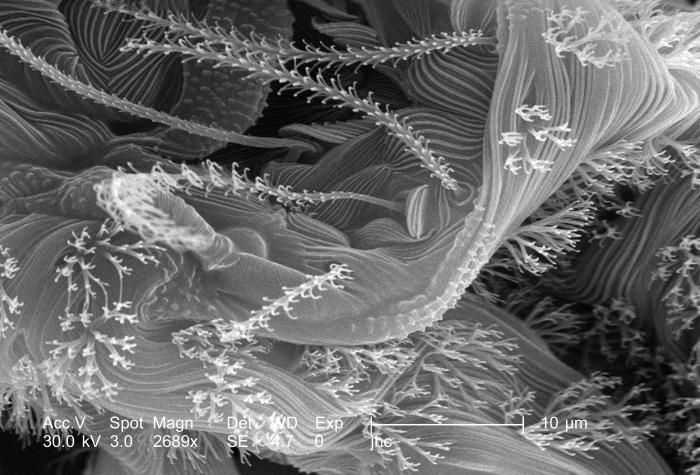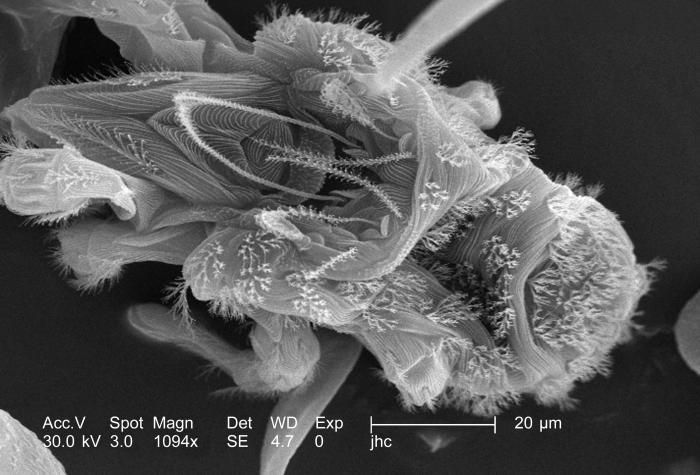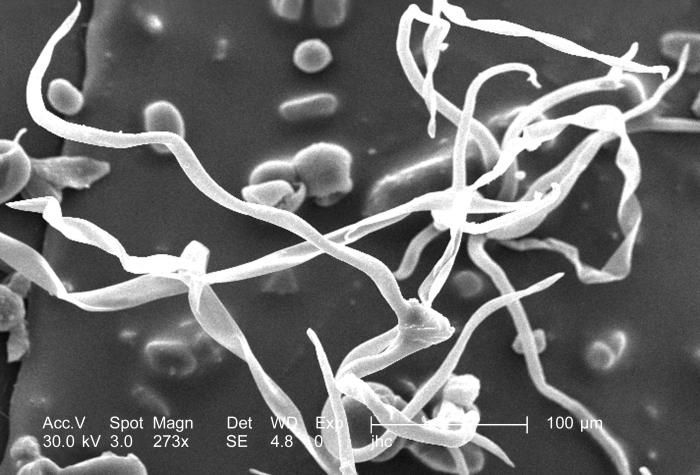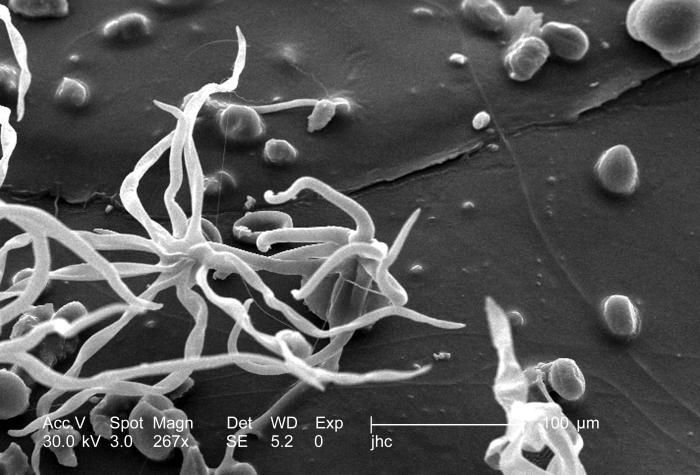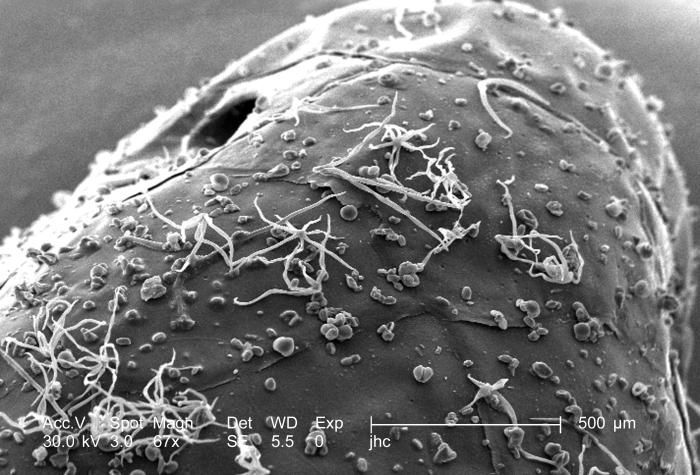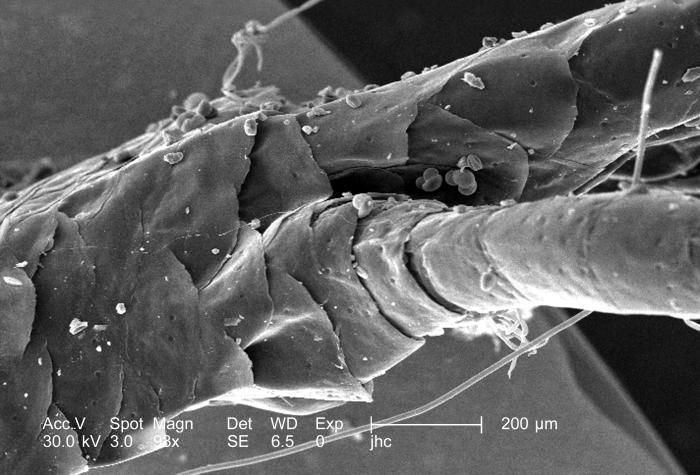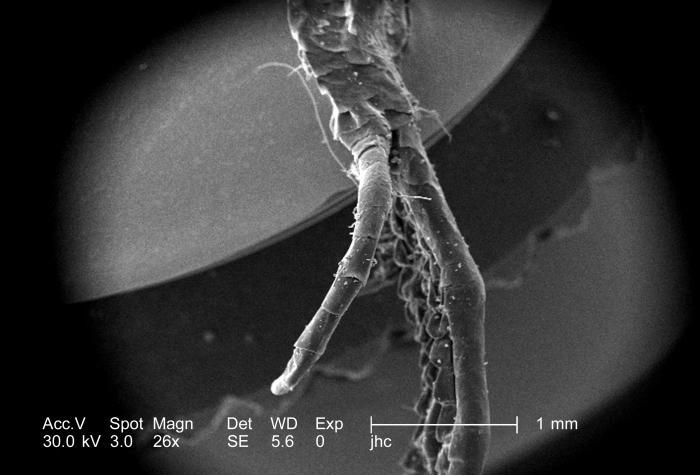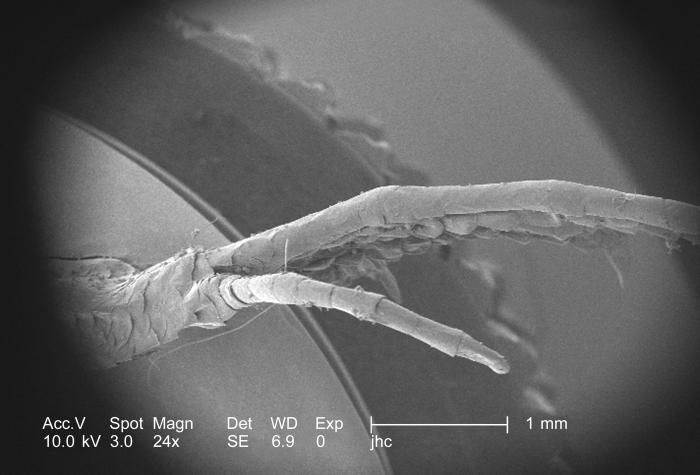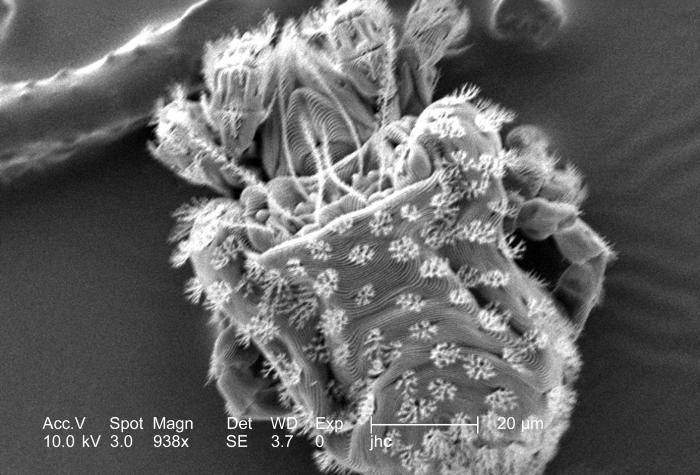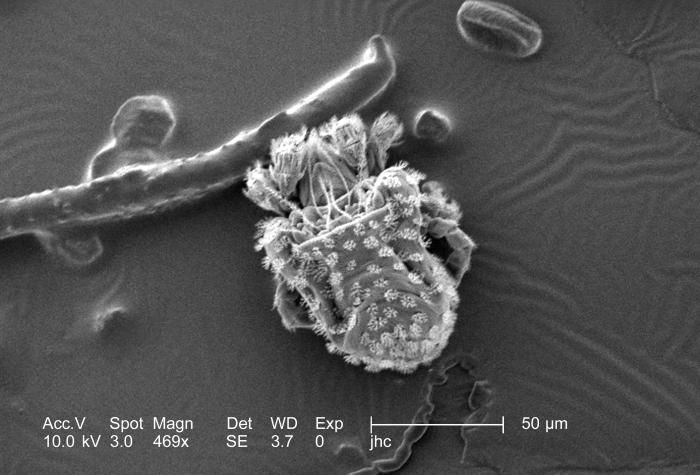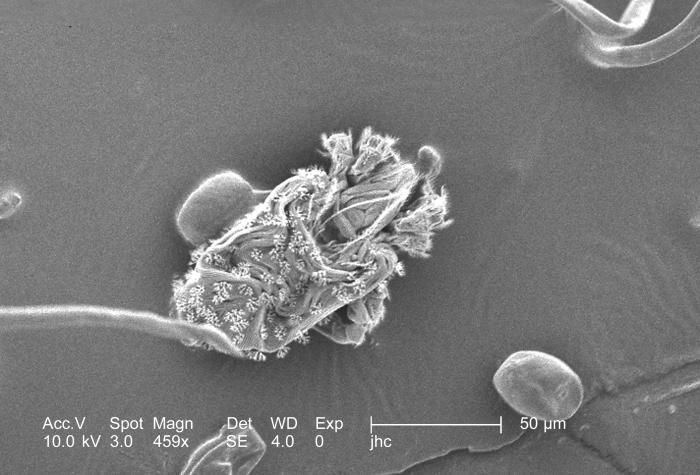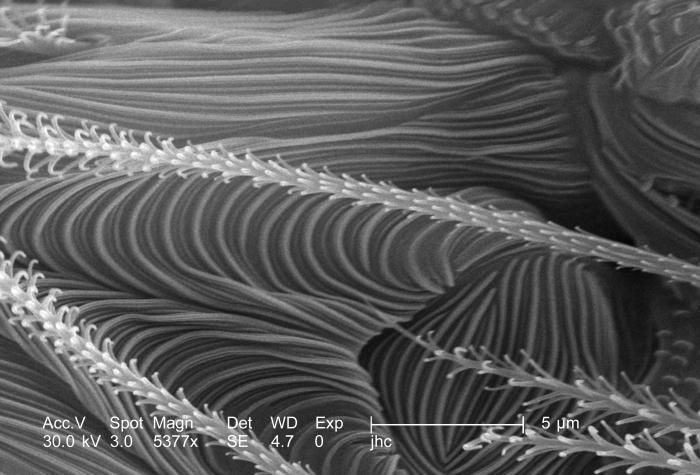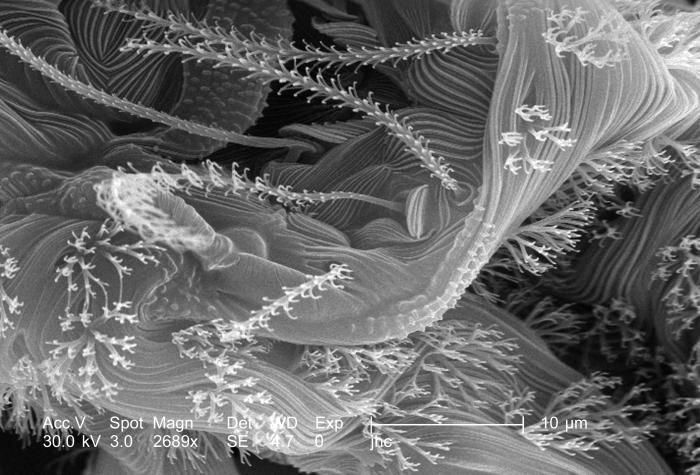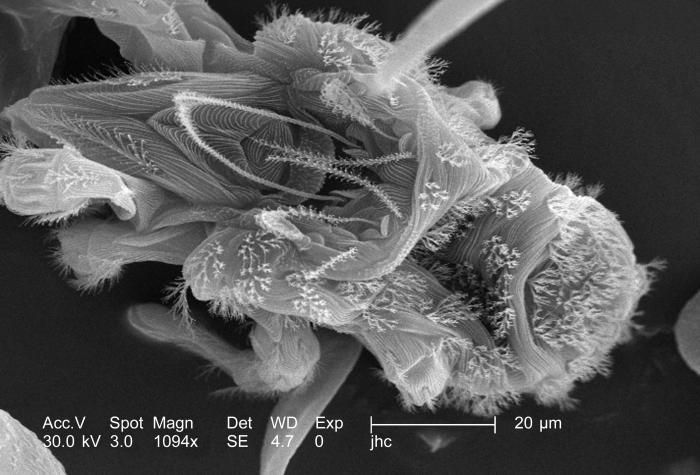-
Photographed here under a low magnification of 98x, this scanning electron micrograph (SEM) depicted some of the external morphologic features of a deceased lizards foot found desiccated on the suburban grounds of Decatur, Georgia. Note the armor-like appearance of the horny scaled exterior. The clawed morphology displayed by the reptile's foot closely reflects that displayed by birds as well.Created: 2006
-
Photographed here under a low magnification of 26x, this scanning electron micrograph (SEM) depicted some of the external morphologic features of a deceased lizards foot found desiccated on the suburban grounds of Decatur, Georgia. Note the armor-like appearance of the horny scaled exterior. The clawed morphology displayed by the reptile's foot closely reflects that displayed by birds as well.Created: 2006
-
Photographed here under a low magnification of 24x, this scanning electron micrograph (SEM) depicted some of the external morphologic features of a deceased lizards foot found desiccated on the suburban grounds of Decatur, Georgia. Note the armor-like appearance of the horny scaled exterior. The clawed morphology displayed by the reptile's foot closely reflects that displayed by birds as well.Created: 2006
-
Under a moderately high magnification of 938x, this scanning electron micrograph (SEM) revealed the presence of numbers of mites from the specie Nanorchestes sp., Family Nanorchestidae. Members of this specie are free-living, fungivorous soil and leaf-litter/moss mites that were simply an incidental finding on the skin of this lizard. It is not a lizard associate per se, and certainly not parasitic. Under higher magnifications, i.e., PHIL 8808, 8809, the mites exoskeletal complexities are better appreciated in their diaphanous majesty.Created: 2006
-
Under a magnification of 469x, this scanning electron micrograph (SEM) revealed the presence of numbers of mites from the specie Nanorchestes sp., Family Nanorchestidae. Members of this specie are free-living, fungivorous soil and leaf-litter/moss mites that were simply an incidental finding on the skin of this lizard. It is not a lizard associate per se, and certainly not parasitic. Under higher magnifications, i.e., PHIL 8808, 8809, the mites exoskeletal complexities are better appreciated in their diaphanous majesty.Created: 2006
-
Under a magnification of 459x, this scanning electron micrograph (SEM) revealed the presence of numbers of mites from the specie Nanorchestes sp., Family Nanorchestidae. Members of this specie are free-living, fungivorous soil and leaf-litter/moss mites that were simply an incidental finding on the skin of this lizard. It is not a lizard associate per se, and certainly not parasitic. Under higher magnifications, i.e., PHIL 8808, 8809, the mites exoskeletal complexities are better appreciated in their diaphanous majesty.Created: 2006
-
Under a high magnification of 6601x, this scanning electron micrograph (SEM) revealed the presence of numbers of mites from the specie Nanorchestes sp., Family Nanorchestidae, which was highly festooned with an adornment of chitinous exoskeletal outcroppings. Under this high magnification, these exoskeletal complexities were better appreciated in their diaphanous majesty. Members of this specie are free-living, fungivorous soil and leaf-litter/moss mites that were simply an incidental finding on the skin of this lizard. It is not a lizard associate per se, and certainly not parasitic.Created: 2006
-
Under a high magnification of 5377x, this scanning electron micrograph (SEM) revealed the presence of numbers of mites from the specie Nanorchestes sp., Family Nanorchestidae, which were highly festooned with an adornment of chitinous exoskeletal outcroppings. Under this high magnification, these exoskeletal complexities were better appreciated in their diaphanous majesty.Created: 2006
-
Under a high magnification of 2689x, this scanning electron micrograph (SEM) revealed the highly ornate ultrastructural morphology associated with the exoskeletal surface of a mite found on the skin of a deceased lizard, on the grounds of the Decatur, Georgia suburbs. As a member of the specie Nanorchestes sp., Family Nanorchestidae, this is a free-living, fungivorous soil and leaf-litter/moss mite that was simply an incidental finding on the exterior of this lizard. It is not a lizard associate per se and certainly not parasitic.Created: 2006
-
Under a moderately high magnification of 1094x, this scanning electron micrograph (SEM) revealed the presence of numbers of mites from the specie Nanorchestes sp., Family Nanorchestidae, which were highly festooned with an adornment of chitinous exoskeletal outcroppings. Under higher magnifications, i.e., PHIL 8808, 8809, these exoskeletal complexities were better appreciated in their diaphanous majesty.Created: 2006
-
Under a moderately high magnification of 547x, this scanning electron micrograph (SEM) revealed the presence of numbers of mites from the specie Nanorchestes sp., Family Nanorchestidae, which were highly festooned with an adornment of chitinous exoskeletal outcroppings. Under higher magnifications, i.e., PHIL 8808, 8809, these exoskeletal complexities were better appreciated in their diaphanous majesty.Created: 2006
-
Magnified 273x, this scanning electron micrograph (SEM) revealed the presence of a coating of debris adhered to the ventral surface of an unidentified lizard's head region, which had been found deceased on the grounds of the Decatur, Georgia suburbs. Note the myriad of what proved to be unidentified pollen grains, and unknown parasitic mites. For the full complement of images related to this specimen see PHIL 8803 through 8816, which includes highly magnified views of a Nanorchestes sp. mite found coincidentally on this repitiles skin.Created: 2006
-
Magnified 267x, this scanning electron micrograph (SEM) revealed the presence of a coating of debris adhered to the ventral surface of an unidentified lizard's head region, which had been found deceased on the grounds of the Decatur, Georgia suburbs. Note the myriad of what proved to be unidentified pollen grains, and unknown parasitic mites. For the full complement of images related to this specimen see PHIL 8803 through 8816, which includes highly magnified views of a Nanorchestes sp. mite found coincidentally on this repitiles skin.Created: 2006
-
Under a low magnification of 67x, this scanning electron micrograph (SEM) revealed the presence of a coating of debris adhered to the ventral surface of an unidentified lizard's head region, which had been found deceased on the grounds of the Decatur, Georgia suburbs. In this field of view was the reptile's left nostril, or naris. Note the myriad of what proved to be unidentified pollen grains, and unknown parasitic mites. For the full complement of images related to this specimen see PHIL 8803 through 8816, which includes highly magnified views of a Nanorchestes sp. mite found coincidentally on this repitiles skin.Created: 2006
-
Photographed here under a low magnification of 98x, this scanning electron micrograph (SEM) depicted some of the external morphologic features of a deceased lizards foot found desiccated on the suburban grounds of Decatur, Georgia. Note the armor-like appearance of the horny scaled exterior. The clawed morphology displayed by the reptile's foot closely reflects that displayed by birds as well.Created: 2006
-
Photographed here under a low magnification of 26x, this scanning electron micrograph (SEM) depicted some of the external morphologic features of a deceased lizards foot found desiccated on the suburban grounds of Decatur, Georgia. Note the armor-like appearance of the horny scaled exterior. The clawed morphology displayed by the reptile's foot closely reflects that displayed by birds as well.Created: 2006
-
Photographed here under a low magnification of 24x, this scanning electron micrograph (SEM) depicted some of the external morphologic features of a deceased lizards foot found desiccated on the suburban grounds of Decatur, Georgia. Note the armor-like appearance of the horny scaled exterior. The clawed morphology displayed by the reptile's foot closely reflects that displayed by birds as well.Created: 2006
-
Under a moderately high magnification of 938x, this scanning electron micrograph (SEM) revealed the presence of numbers of mites from the specie Nanorchestes sp., Family Nanorchestidae. Members of this specie are free-living, fungivorous soil and leaf-litter/moss mites that were simply an incidental finding on the skin of this lizard. It is not a lizard associate per se, and certainly not parasitic. Under higher magnifications, i.e., PHIL 8808, 8809, the mites exoskeletal complexities are better appreciated in their diaphanous majesty.Created: 2006
-
Under a magnification of 469x, this scanning electron micrograph (SEM) revealed the presence of numbers of mites from the specie Nanorchestes sp., Family Nanorchestidae. Members of this specie are free-living, fungivorous soil and leaf-litter/moss mites that were simply an incidental finding on the skin of this lizard. It is not a lizard associate per se, and certainly not parasitic. Under higher magnifications, i.e., PHIL 8808, 8809, the mites exoskeletal complexities are better appreciated in their diaphanous majesty.Created: 2006
-
Under a magnification of 459x, this scanning electron micrograph (SEM) revealed the presence of numbers of mites from the specie Nanorchestes sp., Family Nanorchestidae. Members of this specie are free-living, fungivorous soil and leaf-litter/moss mites that were simply an incidental finding on the skin of this lizard. It is not a lizard associate per se, and certainly not parasitic. Under higher magnifications, i.e., PHIL 8808, 8809, the mites exoskeletal complexities are better appreciated in their diaphanous majesty.Created: 2006
-
Under a high magnification of 6601x, this scanning electron micrograph (SEM) revealed the presence of numbers of mites from the specie Nanorchestes sp., Family Nanorchestidae, which was highly festooned with an adornment of chitinous exoskeletal outcroppings. Under this high magnification, these exoskeletal complexities were better appreciated in their diaphanous majesty. Members of this specie are free-living, fungivorous soil and leaf-litter/moss mites that were simply an incidental finding on the skin of this lizard. It is not a lizard associate per se, and certainly not parasitic.Created: 2006
-
Under a high magnification of 5377x, this scanning electron micrograph (SEM) revealed the presence of numbers of mites from the specie Nanorchestes sp., Family Nanorchestidae, which were highly festooned with an adornment of chitinous exoskeletal outcroppings. Under this high magnification, these exoskeletal complexities were better appreciated in their diaphanous majesty.Created: 2006
-
Under a high magnification of 2689x, this scanning electron micrograph (SEM) revealed the highly ornate ultrastructural morphology associated with the exoskeletal surface of a mite found on the skin of a deceased lizard, on the grounds of the Decatur, Georgia suburbs. As a member of the specie Nanorchestes sp., Family Nanorchestidae, this is a free-living, fungivorous soil and leaf-litter/moss mite that was simply an incidental finding on the exterior of this lizard. It is not a lizard associate per se and certainly not parasitic.Created: 2006
-
Under a moderately high magnification of 1094x, this scanning electron micrograph (SEM) revealed the presence of numbers of mites from the specie Nanorchestes sp., Family Nanorchestidae, which were highly festooned with an adornment of chitinous exoskeletal outcroppings. Under higher magnifications, i.e., PHIL 8808, 8809, these exoskeletal complexities were better appreciated in their diaphanous majesty.Created: 2006


